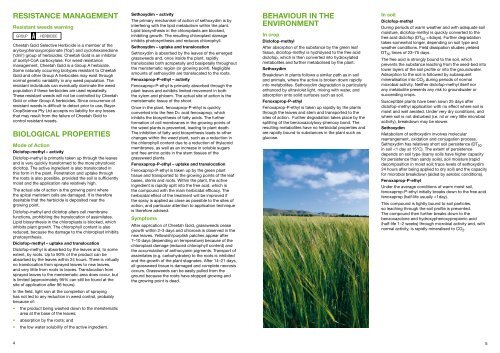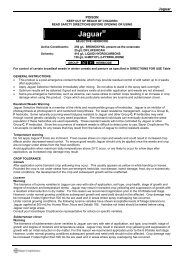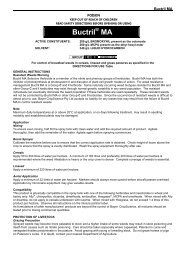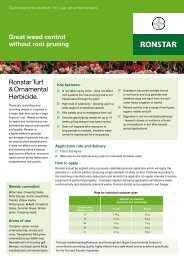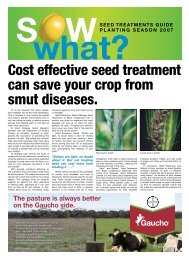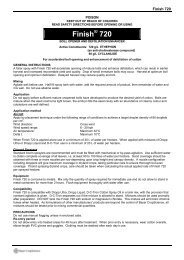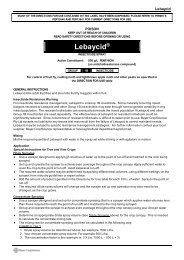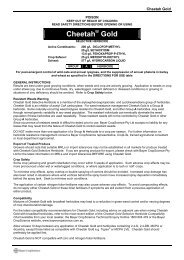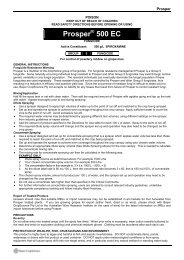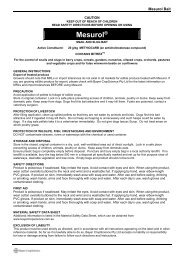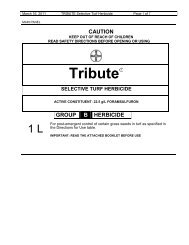TOxICOLOGICAL PROPeRTIeS - Bayer CropScience
TOxICOLOGICAL PROPeRTIeS - Bayer CropScience
TOxICOLOGICAL PROPeRTIeS - Bayer CropScience
You also want an ePaper? Increase the reach of your titles
YUMPU automatically turns print PDFs into web optimized ePapers that Google loves.
RESISTANCE MANAGEMENT<br />
Resistant weeds warning<br />
group A herbicide<br />
Cheetah Gold Selective Herbicide is a member of the<br />
aryloxyphenoxypropionate (‘fop’) and cyclohexanedione<br />
(‘dim’) group of herbicides. Cheetah Gold is an inhibitor<br />
of acetyl-CoA carboxylase. For weed resistance<br />
management, Cheetah Gold is a Group A herbicide.<br />
Some naturally occurring biotypes resistant to Cheetah<br />
Gold and other Group A herbicides may exist through<br />
normal genetic variability in any weed population. The<br />
resistant individuals can eventually dominate the weed<br />
population if these herbicides are used repeatedly.<br />
These resistant weeds will not be controlled by Cheetah<br />
Gold or other Group A herbicides. Since occurrence of<br />
resistant weeds is difficult to detect prior to use, <strong>Bayer</strong><br />
<strong>CropScience</strong> Pty Ltd accepts no liability for any losses<br />
that may result from the failure of Cheetah Gold to<br />
control resistant weeds.<br />
BIOLOGICAL PROPERTIES<br />
Mode of Action<br />
Diclofop-methyl – activity<br />
Diclofop-methyl is primarily taken up through the leaves<br />
and is very quickly transformed to the more phytotoxic<br />
diclofop. The active ingredient is also translocated in<br />
this form in the plant. Penetration and uptake through<br />
the roots is also possible, provided the soil is sufficiently<br />
moist and the application rate relatively high.<br />
The actual site of action is the growing point where<br />
the apical meristem cells are damaged. It is therefore<br />
desirable that the herbicide is deposited near the<br />
growing point.<br />
Diclofop-methyl and diclofop alters cell membrane<br />
functions, prohibiting the translocation of assimilates.<br />
Lipid biosynthesis in the chloroplasts is blocked, which<br />
inhibits plant growth. The chlorophyll content is also<br />
reduced, because the damage to the chloroplast inhibits<br />
photosynthesis.<br />
Diclofop-methyl – uptake and translocation<br />
Diclofop-methyl is absorbed by the leaves and, to some<br />
extent, by roots. Up to 90% of the product can be<br />
absorbed by the leaves within 24 hours. There is virtually<br />
no translocation from sprayed leaves to new leaves,<br />
and very little from roots to leaves. Translocation from<br />
sprayed leaves to the meristematic area does occur, but<br />
is limited (approximately 95% can still be found at the<br />
site of application after 96 hours).<br />
Sethoxydim – activity<br />
The primary mechanism of action of sethoxydim is by<br />
interfering with the lipid metabolism within the plant.<br />
Lipid biosynthesis in the chloroplasts are blocked,<br />
inhibiting growth. The resulting chloroplast damage<br />
inhibits photosynthesis and reduces chlorophyll.<br />
Sethoxydim – uptake and translocation<br />
Sethoxydim is absorbed by the leaves of the emerged<br />
grassweeds and, once inside the plant, rapidly<br />
translocates both acropetally and basipetally throughout<br />
the meristematic region (or growing point). Negligible<br />
amounts of sethoxydim are translocated to the roots.<br />
Fenoxaprop-P-ethyl – activity<br />
Fenoxaprop-P-ethyl is primarily absorbed through the<br />
plant leaves and exhibits limited movement in both<br />
the xylem and phloem. The actual site of action is the<br />
meristematic tissue of the shoot.<br />
Once in the plant, fenoxaprop-P-ethyl is quickly<br />
converted into the free D+ acid fenoxaprop, which<br />
inhibits the biosynthesis of fatty acids. The further<br />
formation of cell membranes in the growing points of<br />
the weed plants is prevented, leading to plant death.<br />
The inhibition of fatty acid biosynthesis leads to other<br />
changes within the weed plant, such as a reduction in<br />
the chlorophyll content due to a reduction of thylacoid<br />
membranes, as well as an increase in soluble sugars<br />
and free amino acids in the stem tissues of the<br />
grassweed plants.<br />
Fenoxaprop-P-ethyl – uptake and translocation<br />
Fenoxaprop-P-ethyl is taken up by the green plant<br />
tissue and transported to the growing points of the leaf<br />
bases, stems and roots. Within the plant, the active<br />
ingredient is rapidly split into the free acid, which is<br />
the compound with the main herbicidal efficacy. The<br />
herbicidal effect of the treatment will be improved if<br />
the spray is applied as close as possible to the sites of<br />
action, and particular attention to application technique<br />
is therefore advised.<br />
Symptoms<br />
After application of Cheetah Gold, grassweeds cease<br />
growth within 2–3 days and chlorosis is observed in the<br />
new leaves. Yellowish/purplish patches appear after<br />
7–10 days (depending on temperature) because of the<br />
chloroplast damage (reduced chlorophyll content) and<br />
the accumulation of anthocyanin pigments. Transport of<br />
assimilates (e.g. carbohydrates) to the roots is inhibited<br />
and the growth of the plant stagnates. After 14–21 days,<br />
all grassweed tissue is damaged and complete necrosis<br />
occurs. Grassweeds can be easily pulled from the<br />
ground because the roots have stopped growing and<br />
the growing point is dead.<br />
BEHAVIOUR IN THE<br />
ENVIRONMENT<br />
In crop<br />
Diclofop-methyl<br />
After absorption of the substance by the green leaf<br />
tissue, diclofop-methyl is hydrolysed to the free acid<br />
diclofop, which is then converted into hydroxylated<br />
metabolites and further metabolised by the plant.<br />
Sethoxydim<br />
Breakdown in plants follows a similar path as in soil<br />
and animals, where the active is broken down rapidly<br />
into metabolites. Sethoxydim degradation is particularly<br />
enhanced by ultraviolet light, mixing with water, and<br />
adsorption onto solid surfaces such as soil.<br />
Fenoxaprop-P-ethyl<br />
Fenoxaprop-P-ethyl is taken up rapidly by the plants<br />
through the leaves and stem and transported to the<br />
sites of action. Further degradation takes place by the<br />
splitting of the benzoxazolyloxy-phenoxy bond. The<br />
resulting metabolites have no herbicidal properties and<br />
are rapidly bound to substances in the plant such as<br />
glucose.<br />
In soil<br />
Diclofop-methyl<br />
During periods of warm weather and with adequate soil<br />
moisture, diclofop-methyl is quickly converted to the<br />
free acid diclofop (DT 50


